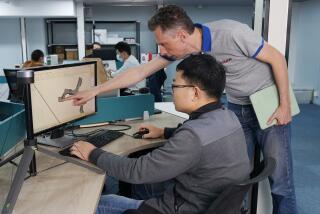Japanese Companies Turning Focus to Asia : Trade: With U.S. and European sales down, Japan looks to neighbors with soaring economies.
- Share via
TOKYO — With business prospects still dim in the West and in their sluggish home market, Japanese companies are increasingly turning to fast-growing Asian economies for investment, export markets and cheaper labor.
Despite the global recession, the hot Asian economies are growing at annual rates of 7% or higher.
As sales in the United States and European markets languish--hit by recession and by the yen’s surging value against other currencies--Japan’s exports to east and southeast Asia have soared.
So have orders for overseas production of Japanese manufactured products. Almost daily reports that Japanese companies--Hitachi, Sanyo, Ricoh, Sharp--are sending work orders overseas to cut labor costs have revived dormant fears that corporations are abandoning their work forces for cheaper labor overseas.
Japan is gradually giving up its manufacturing turf to lower-cost producers in Asia. But economists tend to discount panicky headlines about the “kudoka,” or hollowing out, of Japan’s industrial base.
“Will unemployment be massive? No. More? Yes,” says Kenneth S. Courtis, strategist at Deutsche Bank Capital Markets. “Inefficient companies are being scythed down. They’ve never seen such radical restructuring.”
Courtis estimates that in the medium term, Japan’s unofficial unemployment rate could rise as high as 5%--more than double the current rate--as the labor force adjusts to a slower rate of economic growth and tougher competition from developing nations.
But with Japan’s labor force shrinking as the society ages, the jobless rate is unlikely to climb much beyond that. And many firms worry that too-large cutbacks now will leave them shorthanded when the economy recovers.
Japan’s official unemployment figures tend to understate the problem, although the jobless rate here does remain well below that in most other industrialized countries.
Most companies are trimming their work forces through voluntary retirement and reduced hirings, avoiding outright layoffs.
C.H. Kwan, Asian economist at Nomura Research Institute, says that instead of a “kudoka,” or hollowing out, Japanese firms are undertaking a “kodoka,” or upgrade of their technology and efficiency, ceding less sophisticated production processes to lower-wage Asian neighbors.
Manufacturers began transferring production capacity overseas in the mid-1980s, when Western leaders initially agreed that a weak yen was unduly enhancing Japan’s export competitiveness.
Since then, they have poured a steady stream of investment into factories from Jakarta to Shanghai, gradually transferring production of low-end electronics products overseas.
Although an exact regional breakdown is not available, in the past decade, the number of color televisions Japanese manufacturers produced overseas more than doubled, to 22.7 million a year. The number of VCRs assembled abroad more than tripled.
Overseas production of many other electronics products, from CD players to automatic washing machines, also grew exponentially, according to the Electronic Industries Assn. of Japan.
The yen’s precipitous surge to as high as 100.40 yen against the dollar from about 125 yen in February has accelerated that trend, as firms cut costs by using cheaper labor overseas.
But executives in Japan, unlike their American counterparts, say they intend to keep the manufacturing base for their newest technology at home.
“Many American computer companies use circuit boards from Taiwan for their computers. But we think they’re the most important component, so of course we make them ourselves,” says Tadashi Aikawa, executive managing director of Matsushita Electric Industrial Co.’s computer operations.
“There is no hollowing here,” Aikawa said, though he admitted that the company would consider shifting more output overseas if the yen continued to rise.
During the first “endaka” or “high yen” wave in 1985-87, much of Japan’s investment went to North America and Europe as manufacturers tried to soothe trade friction by locating factories in their export markets.
As of March 31, 1992, Japan had invested $107.2 billion in North America, compared with $30.9 billion in Asia.
Southeast Asian countries, which traditionally specialized in exports of raw materials like petroleum, rubber and palm oil, may benefit more this time around.
Years of foreign investment have improved their infrastructure, raised the level of industrialization and helped create a growing middle-class eager to buy the consumer products that have already saturated more mature markets elsewhere.
Japan’s Booming Trade With Asia
As economic growth slows in the West, Japanese companies are turning to the red-hot economies of Asia’s newly industrialized countries for markets, investment and cheaper labor.
In billions of dollars
Trade surplus Worldwide trade Trade surplus Year with Asia surplus with U.S. 1982 0.2 6.9 12.2 1983 6.6 20.5 18.2 1984 6.2 33.6 37.0 1985 9.1 46.1 43.5 1986 16.6 82.7 54.5 1987 15.2 79.7 57.0 1988 18.9 77.6 52.6 1989 18.0 64.3 48.4 1990 22.2 52.2 41.7 1991 31.7 77.8 43.4 1992 41.9 106.6 49.4
Source: Japanese Finance Ministry
More to Read
Inside the business of entertainment
The Wide Shot brings you news, analysis and insights on everything from streaming wars to production — and what it all means for the future.
You may occasionally receive promotional content from the Los Angeles Times.










